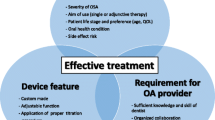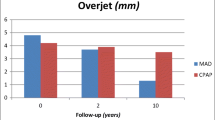Abstract
Purpose
In 2005, the American Academy of Sleep Medicine stated, “Oral appliances are indicated for use in patients with mild to moderate obstructive sleep apnea (OSA) who prefer them to CPAP therapy, or who do not respond to, are not appropriate candidates for, or who fail treatment attempts with CPAP.” However, this recommendation is based upon variable results from only six studies with more than 100 participants. These studies have assessed the effectiveness of mandibular advancement devices (MADs) in specific groups (military populations, academic institutions, or hospital settings) with no large study conducted in a fee-for-service private practice where the majority of patients receive MADs for OSA. The purpose of this study is to report outcomes of a board-certified dental sleep practitioner managing mild, moderate, and severe OSA using customized titratable MADs. We hypothesize that patients will demonstrate a significant reduction in apnea-hypopnea index (AHI) scores after adjusting their customized titratable MADs.
Methods
This is a 14-year retrospective study design with pre- and post-treatment sleep studies. An AHI score < 10 respiratory events per hour with therapy is defined as treatment success. This study was performed by a single private practitioner.
Results
Of 2419 patient records analyzed, 544 (22%) had pre- and post-treatment sleep studies (89% polysomnograms). Of 510 patients with complete data, 459 (90%) revealed a decrease in AHI score < 10 respiratory events per hour indicating treatment success.
Only 51 of these patients (10%) had a final AHI ≥ 10 and were considered treatment failures. Among the patients who lacked post overnight polysomnogram, 66/1921 (3%) discontinued the MAD due to adverse effects. Considering these patients as treatment failures as well, and therefore adding their number to the patients with complete sleep study data, the total treatment failures were 117/576 or 20%. Of the treatment successes, OSA was categorized by AHI at baseline as mild in 170 (34%), moderate in 181 (36%), and severe in 138 (28%).
Conclusions
In patients with evaluable data, there was an 80% success rate for treatment of OSA using a custom-fabricated adjustable MAD including substantial numbers of patients with moderate and severe disease.




Similar content being viewed by others
References
“Asthma at a Glance,” National Center for Environmental Health (NCEH), U.S. CDC, 1999
CDC (2011) National diabetes fact sheet: national estimates and general information on diabetes and prediabetes in the United States, 2011. US Department of Health and Human Services, CDC, Atlanta
Young T, Finn L, Peppard PE, Szklo-Coxe M, Austin D, Nieto FJ, Stubbs R, Hla KM (2008) Sleep disordered breathing and mortality: eighteen-year follow-up of the Wisconsin sleep cohort. Sleep 31:1071–1078
Young T (2009) Rationale, design and findings from the Wisconsin Sleep Cohort Study: toward understanding the total societal burden of sleep disordered breathing. Sleep Med Clin 49:37–46
Marin JM, Agusti A, Villar I, Forner M, Nieto D, Carrizo SJ, Barbé F, Vicente E, Wei Y, Nieto FJ, Jelic S (2012) Association between treated and untreated obstructive sleep apnea and risk of hypertension. JAMA 307(20):2169–2176
Maher K, The new face of sleep. NY Times, February1,2010
Matson S, Sree R First Quarter 2016 Sleep center survey results, Sleep Review Magazine, May 2, 2016
Ferguson KA, Ono T, Lowe AA, Keenan SP, Fleetham JA (1996) A randomized crossover study of an oral appliance vs nasal-continuous positive airway pressure in the treatment of mild-moderate obstructive sleep apnea. Chest 109(5):1269–1275
Hofstein V (2007) Review of oral appliances for treatment of sleep-disordered breathing. Sleep Breath 11:1–22
Chan AS, Sutherland K, Schwab RJ, Zeng B, Petocz P, Lee RW, Darendeliler MA, Cistulli PA (2010) The effect of mandibular advancement on upper airway structure in obstructive sleep apnoea. Thorax 65:726–732
Kushida CA, Morgenthaler TI, Littner MR, Alessi CA, Bailey D, Jr CJ, Friedman L, Hirshkowitz M, Kapen S, Kramer M, Lee-Chiong T, Owens J, Pancer JP (2006) Practice parameters for the treatment of snoring and obstructive sleep apnea with oral appliances: an update for 2005. Sleep 29(2):240–243
Gagnadoux F, Fleury B, Vielle B, Pételle B, Meslier N, N’Guyen XL, Trzepizur W, Racineux JL (2009) Titrated mandibular advancement versus positive airway pressure for sleep apnoea. Eur Respir J 34:914–920
Kim JH, Kwon MS, Song HM, Lee BJ, Jang YJ, Chung YS (2009) Compliance with positive airway pressure treatment for obstructive sleep apnea. Clin Exp Otorhinolaryngol 2:90–96
Young T (2013) Don’t start celebrating—CPAP adherence is still a problem. J Clin Sleep Med 9(6):552
Phillips CL, Grunstein RR, Darendeliler MA, Mihailidou AS, Srinivasan VK, Yee BJ, Marks GB, Cistulli PA (2013) Health outcomes of continuous positive airway pressure versus oral appliance treatment for obstructive sleep apnea: a randomized controlled trial. Am J Respir Crit Care Med 187(8):879–887
Li W, Xiao L, Hu J (2013) The comparison of CPAP and oral appliances in treatment of patients with OSA: a systematic review and meta-analysis. Respir Care 58(7):1184–1195
Yoshida K (2000) Effects of a mandibular advancement device for the treatment of sleep apnea syndrome and snoring on respiratory function and sleep quality. Cranio 18(2):98–105
Marklund M, Stenlund H, Franklin KA (2004) Mandibular advancement devices in 630 men and women with obstructive sleep apnea and snoring tolerability and predictors of treatment success. Chest 125(4):1270–1278
Holley AB, Lettieri CJ, Shah AA (2011) Adjustable oral appliance and comparison with continuous positive airway pressure for the treatment of obstructive sleep apnea syndrome. Chest 140(6):1511–1516
Lam B, Sam K, Mok WY, Cheung MT, Fong DY, Lam JC, Lam DC, Yam LY, Ip MS (2007) Randomized study of three non-surgical treatment in mild to moderate obstructive sleep apnea. Thorax 62(4):354–359
Friedman M, Hamilton C, Samuelson CG, Kelley K, Pearson-Chauhan K, Taylor D, Taylor R, Maley A, Hirsch MA (2012) Compliance and efficacy of thermoplastic versus custom mandibular advancement devices. Otolaryngol Head Neck Surg 147(2):379–386
Lettieri CJ, Paolino N, Eliasson AH, Shah AA, Holley AB (2011) Comparison of adjustable and fixed oral appliances for the treatment of obstructive sleep apnea (2011). J Clin Sleep Med 7(5):439–445
Vanderveken OM, Devolder A, Marklund M, Boudewyns AN, Braem MJ, Okkerse W, Verbraecken JA, Franklin KA, De Backer WA, Van de Heyning PH (2008) Comparison of a custom made and a thermoplastic device for the treatment of mild sleep apnea. Am J Respir Crit Care Med 178:197–202
Levendowski DJ, Morgan T, Westbrook P (2012) Initial evaluation of a titration appliance for temporary treatment of obstructive sleep apnea. J Sleep Disord Ther 1(1):101
Almeida FR, Parker JA, Hodges JS, Lowe AA, Ferguson KA (2009) Effect of a titration polysomnogram on the treatment success of a mandibular repositioning appliance. J Clin Sleep Med 5(3):198–204
Local coverage determination (LCD) for positive airway pressure (PAP) devices for the treatment of obstructive sleep apnea (L11528) Jan 1, 2013
Tsai WH, Vazquez JC, Oshima T, Dort L, Roycroft B, Lowe AA, Hajduk E, Remmers JE (2004) Remotely controlled mandibular positioner predicts efficacy of oral appliances in sleep apnea. Am J Respir Crit Care Med 170:366–370
Bonato R, Bradley D (2013) Introducing a novel micro-recorder for the detection of oral appliance compliance: DentiTrac®. Sleep Diagnosis Therapy 8(3):12–15
Weaver EM, Woodson BT, Steward DL (2005) Polysomnography indexes are discordant with quality of life, symptoms, and reaction times in sleep apnea patients. Otolaryngol Head Neck Surg 132(2):255–262
Author information
Authors and Affiliations
Corresponding author
Ethics declarations
Conflict of interest
The authors declare that they have no conflict of interest.
Ethical approval
All procedures performed in studies involving human participants were in accordance with the ethical standards of the institutional and/or national research committee and with the 1964 Declaration of Helsinki and its later amendments or comparable ethical standards. For this type of study, formal consent is not required.
Rights and permissions
About this article
Cite this article
Mintz, S.S., Kovacs, R. The use of oral appliances in obstructive sleep apnea: a retrospective cohort study spanning 14 years of private practice experience. Sleep Breath 22, 541–546 (2018). https://doi.org/10.1007/s11325-018-1643-5
Received:
Revised:
Accepted:
Published:
Issue Date:
DOI: https://doi.org/10.1007/s11325-018-1643-5




